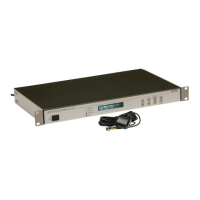7.4 Connecting Outputs 57
Therefore, if you had 10 mA of load current (I load) the available voltage (Vpp) would be 4.304
Vpp. If the load current equals 100 mA, then the available voltage would be 2.54 Vpp. So, you
can see how the increasing load current (i.e number of loads) affects the available drive voltage at
the clock output. See also Table 7.1.
7.4.6 Wire Losses
Another factor affecting the available voltage is the resistive losses through the cabling. Wire has a
certain resistivity associated with it that is determined by its metallic composition, and resistance
determined by the diameter and length. For example, single-strand, 22 AWG (bare, enamel-coated)
copper wire has a resistance of approximately 19.6 ohms per 1000 feet. To compute the loss we
must include both wires in the connection, signal and return. For coaxial cabling, the resistance of
the center conductor is rated differently than the shield. For a twisted pair, both of them should
essentially have the same resistance per cut length. If we use a twisted pair of 22 AWG (copper as
above), then the available voltage (at 100 mA of current) for 500 feet of wire including the source
resistor would be:
(7.3) V pp available = 4.5 − I × 19.6 source − I × 19.6 wire = 0.58 V pp
So, you can see that most of the drive voltage is lost with 100 mA of current and 500 feet of 22
AWG twisted pair transmission line; this includes the voltage losses at the source resistor. 0.58
Vpp may very likely not be detected by the decoder in most IED’s. Remember to make your cable
runs as short as possible, to use a larger diameter cable, and to carefully distribute the loads.
7.4.7 Voltage Matching for Modulated IRIG-B
With modulated IRIG-B, it was mentioned that certain decoders are very intolerant of drive voltage
variation. If the IED specification says that the acceptable voltage range is 3.3 Vpp ±0.5 volt, and
the available voltage is high, then you must reduce the voltage using a dropping resistor (R
drop
).
The value of the dropping resistor is determined by dividing the difference voltage (V
diff
) by the
device current (I
dev
). For example, suppose that the available voltage is 4.5 Vpp, the (nominal)
acceptable voltage is 3.3 Vpp, and the device current is 10 mA. Determine the dropping resistor
value (including the voltage drop due to source resistor).
(7.4) R
drop
= V
diff
÷ I
dev
= (4.3 − 3.3) ÷ 0.01 = 100.4 Ohms
The Power dissipation (P) is:
(7.5) P = I
2
R = 0.01
2
× 120 = 0.01 W atts
In this example, an eighth-watt resistor should work fine.
For a voltage that is too low, the modulated IRIG-B signal level must be increased by some other
means, such as (1) distributing the load differently to reduce the current (raising the available
voltage), (2) by reducing the cable loss by increasing the wire size, or (3) by using an amplifier.

